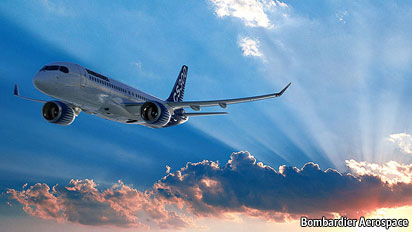
THE distinguished-looking gentleman in traditional Arab dress being shown around a mockup cabin of Bombardier’s new plane at the
The CRJ series seats 50-100 passengers, whereas the category Bombardier is about to enter with the CSeries is the “narrowbody” class, with around 100-200 seats. Until recently airlines only had two choices in this market: Boeing’s best-selling 737 and its (also hugely successful) archrival, the Airbus A320. With demand for air travel forecast to continue growing strongly notwithstanding any short-term economic turbulence, the 737/A320 category is looking ever more tempting to other aircraftmakers. And Bombardier is not the only one planning to enter it. A Chinese firm, Comac, is working on a contender called the C919, and
For both Russians and Chinese, competing in the market for big commercial aircraft is not just a business opportunity but a national project. Yet Bombardier does not seem worried about having two such determined, state-backed rivals. Chet Fuller, an executive at the Canadian firm, says the Russians are “phenomenal” in matters of engineering and design but have no experience in offering what airlines expect these days: producing large quantities of such aircraft to demanding standards as well as reliably providing parts, maintenance and customer support. Kirill Budaev of Irkut admits that these are things his company needs to work on: it is actively seeking foreign partners to provide the expertise that it lacks in these areas.
As for the Chinese, “Ultimately they will succeed at anything they put their minds to,” says Mr Fuller. Perhaps this is why Bombardier is seeking to co-operate with Comac. The two types of planes could be marketed jointly, and the Canadians could help the Chinese firm through the stringent process of getting its C919 certified as airworthy. The firm's two models do not quite overlap, or not yet at least: the Chinese one is at the upper end of the 100-200 seat market whereas the initial versions of the Canadian CSeries will have up to about 150 seats.
Bombardier’s main rival in the market for smaller regional jets, Embraer of Brazil, was also thinking of moving up into the narrowbody airliner category. But a few days ago it decided to drop this idea and will instead concentrate on producing a re-engined version of its E-series regional jets. Bombardier is happy having one fewer competitor in the market, but the Brazilians presumably would not have dropped out if they shared the convictions of the Canadians, Russians and Chinese that there will be lots of orders, and lots of profits, in breaking into the narrowbody duopoly.
Catching up with Airbus’s chief operating officer, John Leahy, as he dashed between contract-signings and news conferences, your reporter asked him which of these rising competitors he feared most. Not the Canadians, Mr Leahy claimed, despite the fact that they are further ahead than the Russians and Chinese in bringing their new plane to market. Bombardier has been marketing the CSeries for three years and ought to have won more orders by now if the plane is going to succeed, he argues. Eventually, he predicts, the Canadian firm, lacking a determined state backer (unlike the Chinese and Russians), will cut its losses and give up. As ever, Bombardier takes Mr Leahy’s barbs as a back-handed compliment: it says that it already has 133 firm orders plus 129 options or other draft purchase agreements for the CSeries—enough to repay the $3.4 billion cost of developing the plane, an official at the firm indicates.
Airbus is seeking to nip its new rivals in the bud by rushing out a re-engined version of its plane, to be called the “A320 neo”, instead of going for a completely new plane, which would have taken much longer to produce. Seeing how many orders Airbus was getting, Boeing decided to do the same, announcing a re-engined “737 MAX”. The Canadians, Russians and Chinese insist that the technology in their new planes will make them more cost-effective to run than the established duopoly’s re-engined ones. Yet they will have to convince airlines to add another type of plane to their fleet—at a time when many are seeking to simplify their operations to save money.
Even so, the arrival of the Canadians, Russians and Chinese in the market will be a useful bargaining chip for airline bosses when negotiating the prices of 737s and A320s with Boeing and Airbus. Ryanair, a huge buyer of 737s, has already let it be known that it is talking to both Comac and Irkut. It will no doubt be expecting its continuing loyalty to Boeing to be well rewarded.


